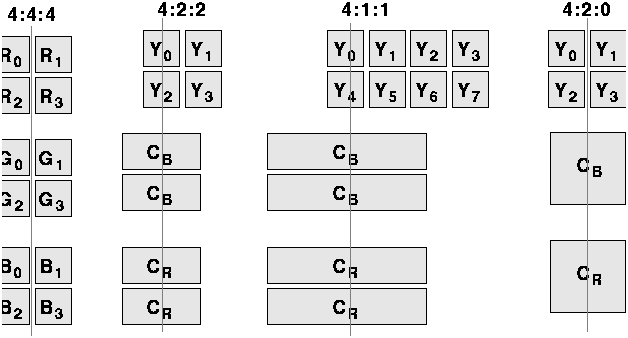Multimedia Communication
Multimedia signal processing is widely used in
- CD-ROM industry: VCD, DVD
- computer industry: image/graphic display
device, audio device; video gaming device; virtual reality; computer vision;
multimedia computer systems
- communication/telecom industry: videophone,
teleconferencing, video/voice over packet-switched networks; mobile video
devices
- TV industry: NTSC/PAL/SECAM analog TV,
digital TV, HDTV
- Movie industry
- Advantages:
- Direct random access --> good for nonlinear video editing
- No problem for repeated recording
- No need for blanking and sync pulse
- Almost all digital video uses component video
Chroma Subsampling
- How to decimate for chrominance?

- 4:2:2 --> Horizontally subsampled color signals by a factor of 2. Each
pixel is two bytes, e.g., (Cb0, Y0)(Cr0, Y1)(Cb2, Y2)(Cr2, Y3)(Cb4, Y4) ...
- 4:1:1 --> Horizontally subsampled by a factor of 4
- 4:2:0 --> Subsampled in both the horizontal and vertical axes by a factor
of 2 between pixels as shown in the figure.
- 4:1:1 and 4:2:0 are mostly used in JPEG and MPEG (see Chapter 4).
ITU-R Standards for Digital Video
BT.601 BT.601 CIF QCIF
525/60 625/50
NTSC PAL/SECAM
-------------------- ----------- ----------- ----------- -----------
Luminance resolution 720 x 480 720 x 576 352 x 288 176 x 144
Chrominance resolut. 360 x 480 360 x 576 176 x 144 88 x 72
Color Subsampling 4:2:2 4:2:2
Fields/sec 60 50 30 30
Interlacing Yes Yes No No
- BT.601 uses interlaced scan, so each field only has half as much
vertical resolution (e.g., 243 lines in NTSC). The BT.601 (NTSC) data rate
is ~165 Mbps.
- CIF (Common Intermediate Format) -- an acceptable temporary standard
- Approximately the VHS quality
- Uses progressive (non-interlaced) scan
- Uses NTSC frame rate, and half the active lines of PAL signals --> To
play on existing TVs, PAL systems need to do frame rate conversion, and NTSC
systems need to do line-number conversion.
- QCIF -- Quarter-CIF
ATSC Digital Television Standard
(ATSC -- Advanced Television Systems Committee) The
ATSC Digital Television Standard
was recommended to be adopted as the Advanced TV broadcasting standard by the
FCC Advisory Committee on Advanced Television Service on November 28, 1995. It
covers the standard for HDTV (High Definition TV).
Video Format
The video scanning formats supported by the ATSC Digital Television Standard
are shown in the following table.
| |
Horizontal Pixels
|
Vertical Lines
|
Aspect Ratio
|
Picture Rate
|
| HDTV |
1920
|
1080
|
16:9
|
60I 30P 24P
|
| HDTV |
1280
|
720
|
16:9
|
60P 30P 24P
|
| SDTV |
704
|
480
|
16:9 & 4:3
|
60I 60P 30P 24P
|
| SDTV |
640
|
480
|
4:3
|
60I 60P 30P 24P
|
- The aspect ratio for HDTV is 16:9 as opposed to 4:3 in NTSC, PAL, and
SECAM. (A 33% increase in horizontal dimension.)
- In the picture rate column, the "I" means interlaced scan, and the "P"
means progressive (non-interlaced) scan.
- Both NTSC rates and integer rates are supported (i.e., 60.00, 59.94,
30.00, 29.97, 24.00, and 23.98).
Rate control
Rate control in video coding is to control the
encoding process or encoding parameters (e.g., quantization step size) so as to
achieve the target bit rate in the coded bit stream.

